If you’re looking for best dairy-free milk alternatives or simply wondering which plant-based options would suit you best, this in-depth guide is for you. I cover as many questions about dairy-free milk as possible: is it for everyone, why you might want to swap, what it can be made from and what does that mean from a nutritional and sustainability standpoint, and how to make your own nut and other plant-based milk. Which dairy-free milk are you typically stocking up on? Let me know your favourite.
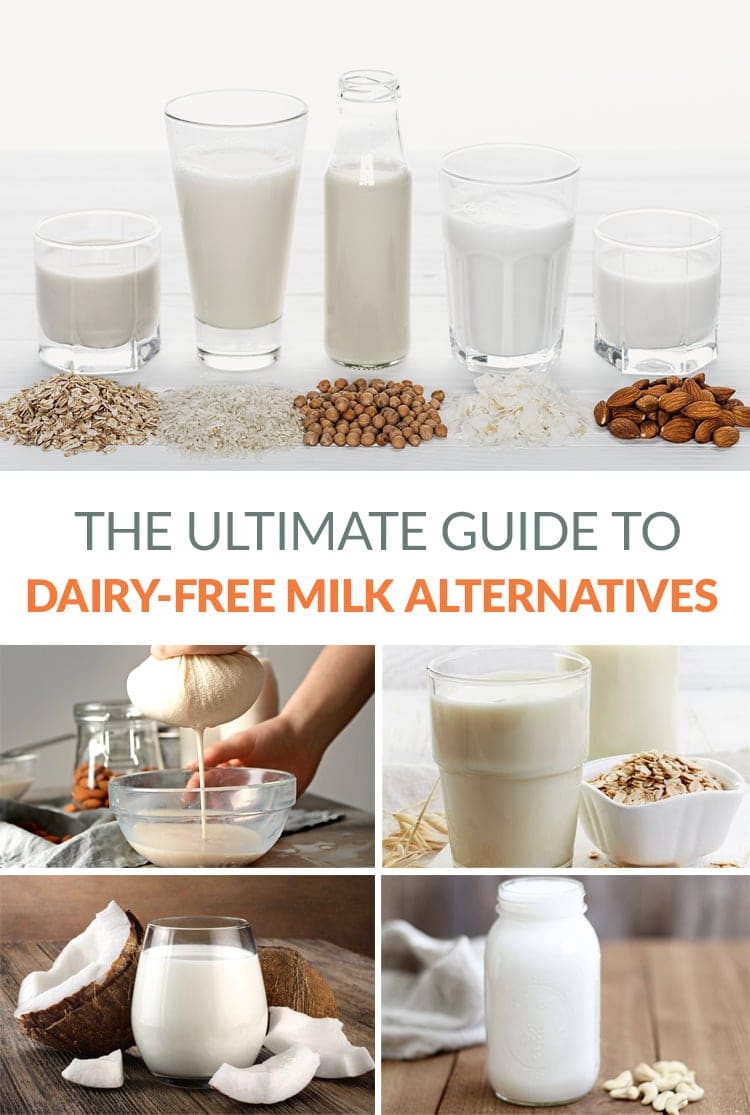
QUICK DIRECTORY
- Almond milk
- Coconut milk
- Soy milk
- Oat milk
- Rice milk
- Hemp milk
- Cashew milk
- Banana milk
- Regular whole milk
Dairy-free milk can be a healthy and in many many cases more sustainable alternative to regular milk, especially for people who are choosing to avoid animal products or have allergies and intolerances to dairy products.
Usually made from plant-based ingredients like nuts, seeds and beans, dairy-free milk was once a novelty product and you could perhaps find two or three options at the big supermarkets or specialised health food stores. These days, you can find milk made from a variety of plants and custom-designed combinations that try to recreate the texture and flavour of regular milk. In fact, it’s an industry worth nearly 2 billion dollars these days.
But, what is the best dairy-free milk? Well, with so much more choice, it’s easy to get confused. Let’s dive into the world of plant-based milk (or mylk) to see what might work best for you.
Why do people choose dairy-free milk?
While cow’s milk has a lot of nutrients like fat-soluble vitamins and calcium, people choose dairy-free alternatives for a variety of reasons.
First, the intolerances are very common. Some folks simply can’t digest dairy without severe discomfort. This can be due to either lactose (sugars) or casein and whey (proteins) in the milk. People who choose to do an elimination diet like the Paleo diet will cut out dairy at least temporarily and may find that they do better without it.
Given that regular milk has more concentrated levels of lactose than say fermented dairy products, some people find that they can eat cheese and yoghurt but get digestive issues with plain milk. This is when dairy-free milk can be a great option. Some folk choose dairy-free milk to cut back on fat or calories for weight loss as plant-based milk options are often lighter.
Vegans opt-out of dairy due to the lack of sustainability and cruelty of the dairy industry. In fact, these reasons compel many people who are not vegan to also choose plant-based milk.
Finally, some people may just prefer the taste! There are a lot of reasons to switch to dairy-free milk.
Should you swap to dairy-free milk?
If you’re curious about any of the above reasons to swap, then yes! At the very least, I think it’s worth a shot. Considering how saturated the market is, there are a lot of milk substitutes to try. There has never been a better time to make the switch and find a really satisfying product to use instead.
Reasons to consider switching:
- Lactose-intolerance or allergy.
- To avoid hormones, antibiotics, and pesticides that dairy cows are given or come into contact with in commercial farming.
- Reducing inflammation, which can be caused by certain components in the milk.
- Not enjoying the taste of dairy milk.
- Autoimmune diseases like Irritable Bowel Syndrome, Crohn’s, or Colitis that can be irritated by dairy.
- Ethical reasons.
Is dairy-free milk for everyone?
There are many options for dairy-free milk that cover a lot of needs and taste preferences. Of course, it’s important to note some allergies are prevalent. For example, almond milk is inaccessible to people with nut allergies. However, you can choose something more allergen-friendly like oat milk or coconut milk.
Unless you are relying on regular dairy milk for certain nutrients to address a specific deficiency or health problem, you can easily switch to a dairy-free alternative without issues. Most dairy-free milk is fortified with calcium and vitamin D to achieve a comparable nutrient profile.
Can you call dairy-free alternatives ‘milk’?
Semantics can be tricky. At the end of the day, these dairy-free alternatives are not milk. While not very marketable, they’re more accurately described as a nut juice. There are some works in progress to not allow non-dairy alternatives to be called milk. You may find products labelled ‘mylk’ or ‘milked nuts’ instead.
Now, let’s go through some popular plant-based milk options on the market today.
Almond Milk
Almond milk is one of the most popular plant-based options and as it has been in the news for good and bad reasons, we’ll start here.
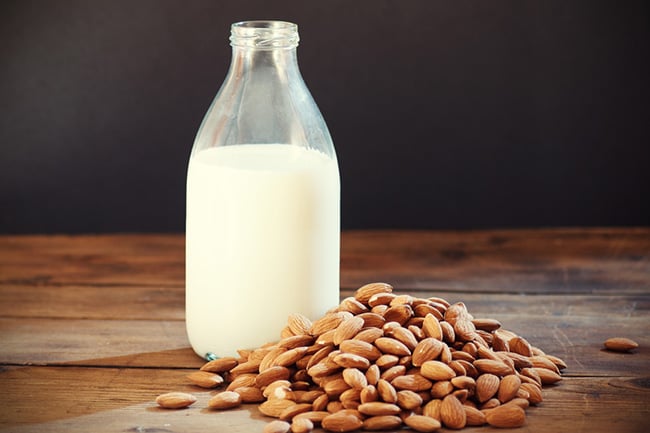
What is almond milk made from?
Almonds and water – sometimes, vanilla or sweetener is added. Almonds and water and blended together, then strained through to remove any pulp to leave the creamy, milky liquid.
Taste, colour, and consistency
Almond milk has a fairly neutral taste. Naturally, it is a little nutty but not overly so. In fact, you don’t get that almond flavour you would in say an almond flour. Even without added sweetener, almond milk has a subtle sweetness that makes it nice with coffee.
The Kitchn aptly describes the flavour as “the milk at the bottom of your cereal bowl after eating Grape Nuts,” and they’re not wrong. Almond milk is quite smooth in consistency and white or off-white, depending on the brand or if you make it homemade.
Almond milk CALORIES & nutrition
Reference: Almond Breeze brand, these numbers may differ depending on the almond content % in the milk.
Per 1 cup (240 mL)
Calories: 30
Total Fat: 2.5 grams
Polyunsaturated fat: 0.5 grams
Monounsaturated fat: 1.5 grams
Cholesterol: 0 mg
Sodium: 170 mg
Potassium: 160 mg
Carbohydrate: 1 gram
Dietary fibre: < 1 gram
Sugars: 0 grams
Protein: 1 gram
Vitamin A: 10%
Calcium: 45%
Vitamin D: 25%
Vitamin E: 50%
Almond milk pros
- It’s easy to find: it’s arguably the most common dairy-free milk so it is easy to access in stores and at establishments like coffee shops. This also means it’s generally the most affordable option, considering how many brands you can choose from.
- It’s low in calories: because of this, commercially produced almond milk can be good for weight loss.
- It’s fairly nutritious: fortified almond milk will help you meet your calcium, vitamin D, and vitamin E needs. It’s also heart-healthy.
Almond milk cons
- Sustainability. Almonds are an extremely water-intensive crop. One almond uses approximately one gallon of water. In the U.S., 90% of almonds are grown in California which is extremely drought-prone and at high wildfire risk (1). Moreover, this is a strain on land use which leads to monocultures (the land where only one crop is grown – an ecological nightmare!). Habitat loss is a major contributing factor to endangerment and extinction of species. Spoiler: it’s not as bad as dairy though.
- It’s mostly water. Commercial almond milk may be nutritious due to fortification, but you won’t be reaping the benefits of eating almonds. One glass of almond milk may contain just 4-5 almonds or around 2% of the product total (2). You can solve this by making your own or choosing brands that contain higher almond content. Look for brands with 4-6% almonds.
Will almond milk suit your diet?
Almond milk is Paleo, vegan, vegetarian, lactose-free, Whole30-compliant, and ketogenic.
Buying almond milk
While this process should be pretty straightforward, there are a few things you should know. First, the main ingredients are almonds and water. Look for almond milk with higher % of almonds. Anything else is not necessary, however, sometimes a little salt is added as a preservative.
Choosing organic products is preferable if you want to avoid pesticides. Many kinds of almond milk are sweetened, so make sure to check for added sugar. Most of the time, this is clearly stated on the front of the label.
Next, you should check for additives. Common additives include gums and carrageenan. These are used as a thickener and a preservative. Carrageenan is a seaweed derivative and not inherently dangerous, but studies are inconclusive so we don’t know if it can contribute to digestive issues or inflammation.
Alternatives include guar gum which can potentially irritate the digestive system and xanthan gum which should be avoided by people with corn allergies. To be safe, you should purchase the product without additives. They do exist, and they are typically more expensive.
Using almond milk
Almond milk can typically be used in any recipe that calls for dairy milk except some recipes that use tinned coconut milk. Almond milk simply doesn’t have the fat content to be used in recipes like curry. You can have it in your oatmeal, cereal, or in creamy stews and soups. Try my almond milk strawberry banana smoothie.
It goes well in coffee. If you enjoy making hot drinks at home, you can whip up a lovely latte with almond milk. It also works in golden milk with turmeric or chai tea.
You can buy almond milk in a shelf-stable formula. This should be stored in your pantry or an otherwise cool and dry place. You can also buy almond milk from the refrigerated section. This should be kept until it’s ‘best by’ date. After opening, it will spoil in around ten days.
How to make almond milk
Almond milk is easy to make at home. You have the added benefit of using more almonds per cup. This, however, increases the calorie content. On the other hand, almonds are full of healthy fats, magnesium, and vitamin E. By making your own, you will lose the benefits of commercial fortification – namely, vitamin D and calcium.
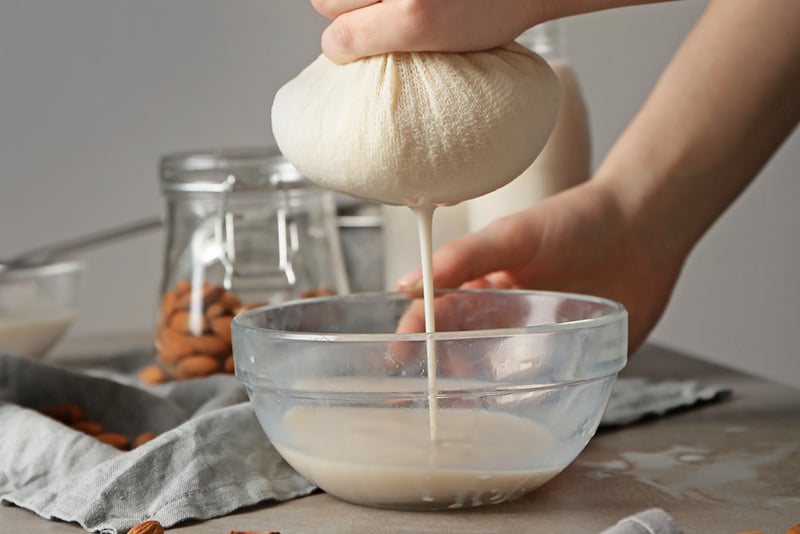
Ingredients:
- 1 cup whole almonds (raw, soaked overnight)
- 5 cups of water
- A pinch of sea salt
- Sweetener or 2 pitted dates to taste (if you want sweetened milk)
Instructions:
- Using a high-speed blender or food processor, blend all ingredients until smooth.
- Using a nut milk bag, thin dish towel, or cheesecloth, strain the liquid through until all the pulp is removed.
- Refrigerate and serve for up to one week.
Verdict
Almond milk is an okay choice! Considering how many other choices are becoming accessible, it is not the best choice in regards to nutrition or sustainability. However, it is a step up from dairy if that’s the direction you’re moving towards.
Coconut Milk
Next on our list is coconut milk. It’s one of my favourite ingredients in general and I do like it as a milk alternative.
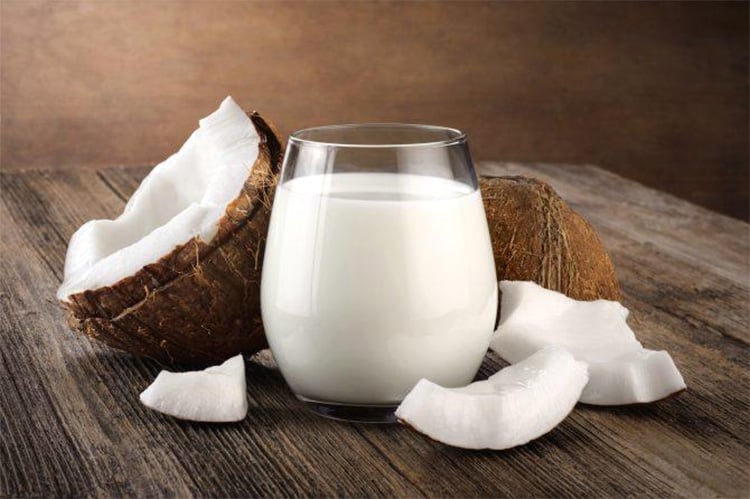
What is coconut milk made from?
There are two main types of coconut milk. The thick coconut milk often found in a can and used in curry or other Thai/Indian dishes is made mostly with coconut flesh and liquid blended into creamy consistency; sometimes, water is added.
Coconut milk drink found as a dairy milk substitute is made from both coconut and water. Sometimes, sweetener and additives are in the product.
Taste, colour, and consistency
Canned coconut milk: This product tastes strongly of coconut. It is bright white in colour. Its consistency is best compared to regular dairy cream. Depending on how well it’s mixed, it can separate into the even thicker coconut cream.
Coconut milk drink: The dairy milk alternative tastes like coconut, but far less concentrated. However, if you don’t enjoy the taste of coconut, it will be noticeable! It is white. Typically, it can separate easily and develop a rather chalky texture. Coconut drink is often mixed with another plant-based milk for a more subtle coconut flavour.
Coconut milk CALORIES & nutrition
Thick and creamy, full-fat coconut milk made with 50-60% coconut is rich and quite caloric. One cup of organic, canned coconut milk comes at 480 calories and 48g of fat but it’s quite low in carbs making it great keto milk. However, you will rarely have a full cup of coconut milk in one go as it is usually mixed into sauces, baking batter or diluted with other liquids in smoothies. For those trying to gain weight, full-fat coconut milk is great for adding extra calories to meals and drinks.
When it comes to coconut milk drinks, nutrition looks a little different. In this case, it’s a diluted form of milk which will often be fortified. Here is the nutritional profile of dairy milk alternative Silk, unsweetened. So, make sure to check the labels if you’re counting macros or looking for fortified varieties.
Per 1 cup (250 mL)
Calories: 50 kcal
Fat: 4.5 grams
Saturated fat: 4 grams
Sodium: 35 grams
Potassium: 30 mg
Carbohydrates: 1 gram
Sugar: < 1 gram
Protein: 0.2 grams
Vitamin A: 10%
Calcium: 30%
Vitamin D: 45%
Riboflavin: 25%
Vitamin B12: 50%
Zinc: 10%
Coconut milk pros
Coconut is a fairly healthy ingredient. The canned variety has a much higher concentration of coconut, therefore containing more of the benefits of the fruit itself.
- Medium-chain triglycerides. MCTs are the type of saturated fat found in coconut. These compounds have been linked to weight loss in studies (3,4). They may also enhance exercise endurance “through the increase of mitochondrial biogenesis and metabolism” (5). Finally, supplemental coconut milk has been shown to aid in managing healthy cholesterol levels by decreasing LDL and raising HDL (6).
- Low-carb. Most milk substitutes are inherently low in carbohydrates, but coconut milk is an especially good choice because of its fat content. This makes it a good contender for keto eaters or people who otherwise want to manage blood sugar and maximise healthy fat intake.
Sustainable. Coconut farming has a low impact on the environment. Coconut trees can sequester carbon thereby offsetting carbon in the atmosphere. - Non-allergenic. Coconut allergy is far less common.
Coconut milk cons
- High in calories. Canned coconut milk is very high in calories and should be used in moderation for weight loss. Ultimately, it is often used in small quantities in things like coffee, or in moderate quantities in multi-serving recipes so it’s not a big deal. Bottled coconut milk is not as high in calories.
- Chalky texture. Coconut milk separates and becomes chalky or dusty. This may mean a glass of coconut milk is not the most refreshing beverage, but this is a personal preference.
Does Coconut milk suit your diet?
Coconut milk is Paleo, vegan, vegetarian, lactose-free, Whole30-compliant, and ketogenic.
Buying coconut milk
If you are buying canned coconut milk, look for plain coconut and/or coconut and water mixes. Some canned varieties contain guar gum which is high in fibre which may help digestion. On the other hand, it can cause some stomach upset. The higher the coconut content (50% or higher), the creamier and thicker the coconut milk will be.
Coconut milk drink will have similar ingredients but with much lower coconut content. You should also look out for added sweeteners.
Using coconut milk
Canned coconut milk is a pantry staple. It is used in curries, soups, stews, and many dishes from India, Thailand, and all over Asia. It can also be used in place of cream in many other recipes if you are looking to make substitutions on your own. Finally, it is a great creamer for coffee – especially if you have a hand frother!
Coconut milk drink can be used in place of dairy milk. It does have a fairly chalky consistency when cold or not mixed, so it’s not the best dairy-free alternative if you simply want a refreshing glass of something creamy. You can, however, dilute canned coconut milk with water to your preferred consistency and creaminess. Try my coconut milk mango chia pudding.
Many people make yoghurt out of thick coconut milk.
Canned coconut milk will last in a cool, dry place for up to two years. After opening refrigerated coconut milk, it will last for around ten days.
How to make coconut milk
Coconut milk is more difficult to make than most milk unless you live in a tropical area. Moreover, coconuts can be difficult to dissect without the right tools or prior experience. There is a workaround, though! You can always buy dried, shredded coconut instead.
Ingredients:
- 2 cups of unsweetened shredded coconut
- 4 cups of water (or less for more concentrated milk)
- A pinch of salt
- Sweetener to taste, if you like
Instructions:
- Add all ingredients to a high-speed blender or food processor and mix for around 2 minutes until fully blended.
- Strain through a nut milk strainer or thin towel into a bowl.
- Refrigerate and use for up to one week.
Verdict
The two versions of coconut milk make it one of the most versatile on the list. It does have a coconut taste, but the drink version is rather neutral. It is one of the most sustainable dairy-free milk options on the market. Overall, it is a really good choice!
Soy Milk
Soy milk was one of the first dairy-free milk alternatives on the market and is very popular in Asian countries, where the majority of people can’t tolerate regular diary. There are many debates about the pros and cons of soy milk, so let’s see.
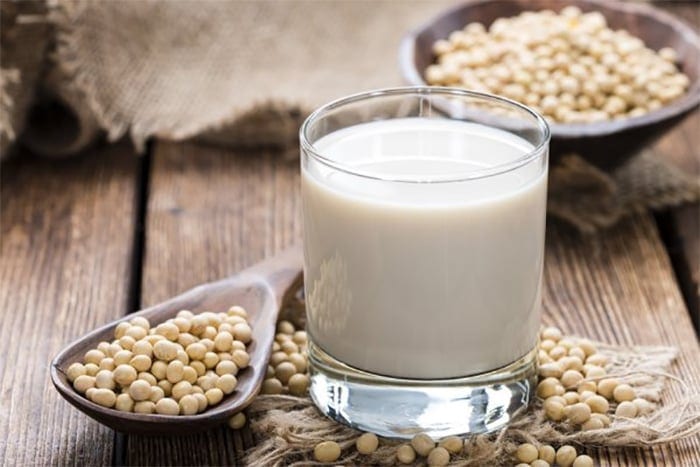
What is soy milk made from?
Soy milk is made from soybeans. After the beans are soaked and ground, they are boiled and filtered into a creamy beverage.
Taste, colour, and consistency
Soy milk is perhaps one of the best dupes for dairy milk because it is very creamy and filling compared to some of the more watery options like coconut and almond milk drinks. The colour is typically an off-white.
It tastes rather neutral and a little nutty the way that most soy products without additional flavouring do (think of tofu, except in milk form). It can be a little ‘bean-y’ though.
SOY MILK CALORIES & NUTRITION
Here are the macros and some nutrients in organic Edensoy unsweetened soy milk. Some brands of soy milk will be fortified with calcium and vitamin D to try and match the nutrients in regular milk.
Per 1 cup (8 oz.)
Calories: 120 kcal
Fat: 6 grams
Saturated fat: 1 gram
Cholesterol: 0 grams
Sodium: 5 mg
Potassium: 460 mg
Carbohydrates: 5 grams
Fibre: < 1 gram
Sugar: 2 grams
Protein: 12 grams
Iron: 10%
Vitamin K: 20%
Folate: 15%
Phosphorous: 15%
Magnesium: 15%
Copper: 10%
Soy milk pros
Soy milk was truly the original dairy-free milk alternative. It’s been around for a while. Now that there are so many more options on the market, it’s been kind of swept under the rug. Time calls it “the healthiest dairy alternative.”.Why is that?
- High in protein. While soy milk is higher in calories than most dairy-free milk, it’s also one of the most nutritious. It maintains the nutritional integrity of the original food used to make it which is rare, to say the least. One cup of soy milk contains a solid 8-12 grams of protein on average making it a great source of fuel. Plus, it’s very filling. This is especially important in plant-based diets.
- Phytonutrients (isoflavones). These compounds have antioxidant properties which can reduce oxidative stress and potentially reduce risk of various ”civilization diseases” such as coronary heart disease, breast cancer, and prostate cancer (7,8,9).
Soy milk cons
- Sustainability. Compared to dairy milk, soy milk is a much more sustainable choice. Soybeans require four times less water. However, growing soy is known to contribute to deforestation in significant ways which in turn leads to habitat loss and displaces indigenous communities all over South America. Most soybean production is for refined oils and food additives.
- Phytic acid. Some people avoid legumes because of phytic acid content. This can bind to other nutrients and inhibit the absorption of them by the body.
- Allergy. Soy is a fairly common allergy, so it’s not accessible to everyone.
- GMOs. Many soybeans come from genetically modified crops.
- Effect on hormones. Soy is a unique food that is widely studied for its estrogenic and anti-estrogenic effects on the body. Studies may seem to present conflicting conclusions about soy, but this is largely due to the wide variation in how soy is studied. However, there is some concern that soy can increase or rather mimic estrogen hormones. This largely depends on the existing level of hormones in the body. If you’re concerned about this, please do more research and consult a hormone specialist. Read more about soy here.
Is soy milk is suitable for your diet?
Soy milk is vegan, vegetarian, gluten-free, nut-free, lactose-free. It’s not considered paleo or Whole30-friendly as it’s made from legumes, which are avoided, and as it’s considered to be a highly processed food.
Buying soy milk
When purchasing soy milk, you should avoid additives and sweeteners, or at least be aware of them. Most additives are vitamin fortifications. The next most common additive is probably carrageenan which we’ve discussed; it is relatively harmless. Despite some claims you will find online, it has been shown to not be carcinogenic and is only harmful in high doses (10). You should also keep an eye out for ‘natural flavours’ that are otherwise undefined and vegetable oil. These things are 100% unnecessary!
Using soy milk
You can use soy milk in place of dairy milk seamlessly in almost all recipes. It is rich and creamy so it’s a good choice for savoury meals. It’s also good for using in coffee, cereals, oats, and other sweet things. It’s quite versatile milk with a very authentic milk texture. It also steams and froths well, so it’s a great option at home or the coffee shop – especially if you enjoy a cappuccino.
You can keep opened soy milk in the refrigerator for up to ten days. You can also buy a shelf-stable version which will keep for one year.
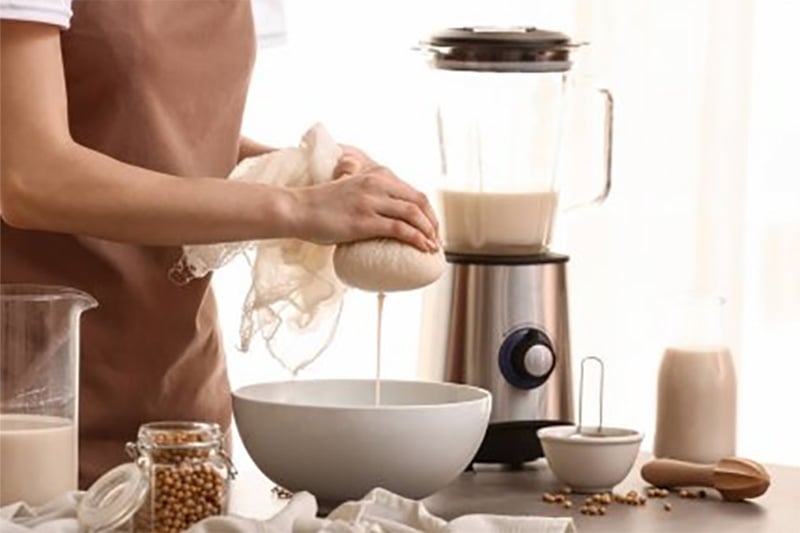
How to make soy milk
Ingredients:
- ½ cup soybeans soaked overnight (yellow is preferable)
- 4 cups of water
- A pinch of salt
- Sweetener or pitted dates to taste
Instructions:
- After soaking your soybeans, drain them and remove the skins. This is optional but will give you a better-tasting final product.
- Blend with 3 cups of water for around 2 minutes or until smooth.
- Strain into a bowl using a nut milk bag or thin towel.
- Using a saucepan, add the mixture and the additional cup of water. Bring to a boil and skim the foam that forms.
- Cover and simmer for around 20 minutes.
- Cool the soy milk and refrigerate for up to one week.
Verdict
Soy milk is a nutritious and creamy dairy alternative. It’s easily the most protein-rich milk alternative out there! It does have some drawbacks for people who want to avoid legumes for any reason including phytic acid content and the potential effect on the hormones. It’s also not strictly ketogenic, but it is quite low in carbohydrates. It also isn’t paleo-friendly or Whole30-compliant which may turn some people off. Finally, it is moderate on the sustainability scale. All in all, it’s a good choice for some and not others.
Oat Milk
This dairy-free milk alternative has gained a lot of popularity in recent years with many new brands of oat milk and products on the market. Is it worth the hype?
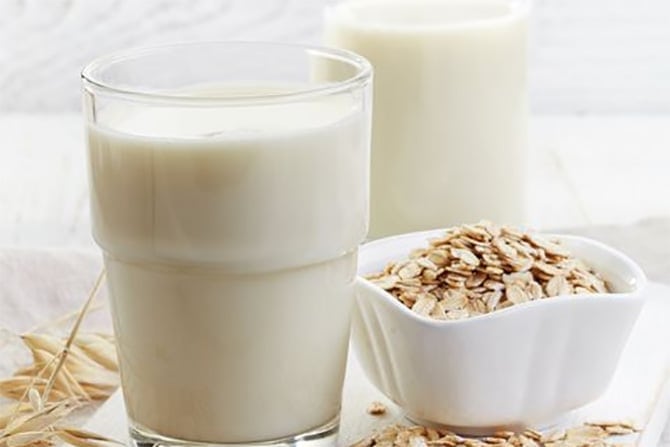
What is oat milk made of?
As the name suggests, oat milk is made of oatmeal! Oats blended with water yield a delicious, creamy, dairy-free alternative to milk.
Taste, colour, and consistency
Oat milk is perhaps the most neutral tasting dairy alternative on the market which likely contributed to its recent rise in popularity. It is effortlessly creamy the way that 2% or whole milk is, making it a comparable substitute. It is slightly off-white. Some may say it’s oatmeal-coloured.
Oat milk calories & nutrition
Based on Califia Farms unsweetened oat milk, you’re looking at the following macros and nutrients. Again, this doesn’t take into account any further fortifications with vitamins or minerals.
Per 1 cup (250 ml/8 oz.)
Calories: 100 kcal
Fat: 7 grams
Saturated fat: 1 gram
Polyunsaturated fat: 0.5 grams
Monounsaturated fat: 5 grams
Cholesterol: 0 mg
Sodium: 100 mg
Potassium: 325 mg
Carbohydrates: 9 grams
Fibre: 1 gram
Sugar: 2 grams
Protein: 2 grams
Calcium: 20%
Oat milk pros
- Fibrous. Unlike many of the other contenders in our dairy-free milk list, oats are naturally very fibrous and retain much of their fibre content in the processing of the milk. You can get 1-2 grams of dietary fibre per serving which can help keep you full and aid in healthy digestion. Moreover, beta-glucans (the type of soluble fibre in oats), is linked to lowering cholesterol (11).
- Sustainable. It takes six times more water to produce almond than oat milk, and even more for dairy milk. It’s one of the more sustainable options.
Oat milk cons
- Grain product. People who follow a low-carb diet, paleo diet or avoid grains for one reason or another, might have to avoid oat milk. However, some people make exceptions for certain foods and perhaps gluten-free oat milk made at home would work for them.
- Higher in carbs. Compared to nut, seed, and legume milk, oats are higher in carbohydrates.
- Contains oil. Many commercial brands contain vegetable oil which is often why the fat content is increased. Refined oils should be avoided when possible. However, in such small amounts, it’s negligible for many. You can also find brands without vegetable oil or make your own.
Does oat milk suit your diet?
Oat-milk is vegan, vegetarian, lactose-free, nut-free and usually gluten-free (although more subject to contamination).
Buying oat milk
Oat milk can be one of the most costly dairy alternatives, so look out for sales! Next, avoid the additives we’ve discussed previously if possible but know they have minimal harmful effects. More importantly, seek out products without added oils or sugars.
Using oat milk
Oat milk is one of the most natural substitutions for dairy milk due to its creamy consistency and neutral taste. You can use it in place of dairy milk in both sweet and savoury recipes with good results. It’s also amazing for making coffee drinks like lattes and cappuccinos since it froths and foams very well.
You can keep an opened container of oat milk in the refrigerator for up to one week.
How to make oat milk
Ingredients:
- 1 cup of rolled oats gluten-free
- 4 cups of water
- A pinch of salt
- Sweetener or pitted dates to taste
Instructions:
- Simply blend ingredients in a high-speed blender or food processor for around one minute.
- Strain through a clean thin towel or t-shirt. According to The Minimalist Baker, a nut milk bag lets through too much pulp.
Verdict
Oat milk is a sustainable and healthy choice for most people. While it doesn’t suit all diets including paleo and low-carb eating plans, it is great for nearly everyone else. It’s delicious and one of the most authentic replacements for dairy milk. If you’d like a cup of cold milk, this is probably the best choice.
Rice Milk
Rice milk has been around for a while, however, it hasn’t got as many followers are soy or almond milk.
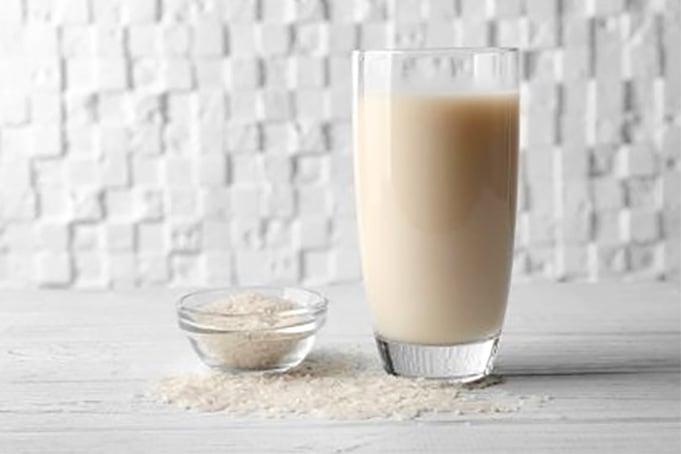
What is rice milk made of?
Rice milk is made of rice and water. Commercially, it’s typically made of brown rice. Rice milk is often mixed with other types for a dairy-free milk drink.
Taste, colour, and consistency
Rice milk is quite watery and less creamy than dairy milk and non-dairy alternatives. It is naturally sweet and great for sweet dishes in particular. Otherwise, its taste is rather neutral compared to coconut milk or soy milk.
Rice milk CALORIES & nutrition
Based on Rice Dream unsweetened rice milk, you’re looking at the following macros.
Per 1 cup (250 ml/8 oz.)
Calories: 120 kcal
Fat: 2.5 grams
Polyunsaturated fat: 0.5 grams
Monounsaturated fat: 1.5 grams
Cholesterol: 0 grams
Sodium: 100 grams
Carbohydrates: 23 grams
Fibre: 0 grams
Sugar: 10 grams
Protein: 1 gram
Calcium: 2%
Iron: 2%
Rice milk pros
- Taste and texture. It’s fairly close to cow’s milk because it’s both creamy and slightly sweet. Rice milk is good if you are keen on cow’s milk.
- Fortification. Rice milk is more nutritious than the label above reads. Most products are also fortified with calcium and vitamin D.
- Naturally gluten-free. Although this is grain-based milk, rice is gluten-free so it is generally safe and healthy. Moreover, rice is an uncommon allergy. Therefore, most people are not sensitive to this product.
Rice milk cons
- High in carbs. Rice milk is the most carbohydrate-heavy of the milk on our list today, and subsequently, the highest in sugar. It may not be best for people who are trying to manage blood sugar, people with diabetes, or those following a ketogenic approach.
- Unsustainable. Rice isn’t ubiquitously unsustainable, but we do run into some problems. Production varies from country to country, and you’ll have to do your research regarding specific products. Is it fair trade? How is rice grown? Rice is a large source of methane compared to other plants (12). It’s still worlds better than traditional dairy, but it’s not the most sustainable of the ‘mylk’ club.
Does rice milk suit your diet?
Rice milk is vegan, vegetarian, lactose-free, nut-free and gluten-free.
Buying rice milk
With rice milk, you should take the same precautions as all other milk previously listed. Avoid additives, oils, and added sugars when you can. Rice milk is sweet enough on its own and has enough naturally occurring carbohydrates!
Using rice milk
Rice milk goes well in sweet recipes. It pairs well with recipes containing bananas, cinnamon, vanilla, honey, or cocoa. It would also work well with oatmeal and cereal. It is a good go-to substitute for baking.
How to make rice milk
Rice milk is a little more complicated than blending a few ingredients and requires some extra steps. Review this recipe from The Minimalist Baker.
Verdict
Rice milk is okay, but a little lacklustre. While it resembles milk quite well, it is mid-range on the sustainability scale and rather high in carbohydrates. However, it’s very allergen-friendly and ultimately quite nutritious when fortified.
Hemp Milk
A newcomer on the market, hemp milk is slowly (but surely) growing its fanbase beyond the New Age and hippy communities.
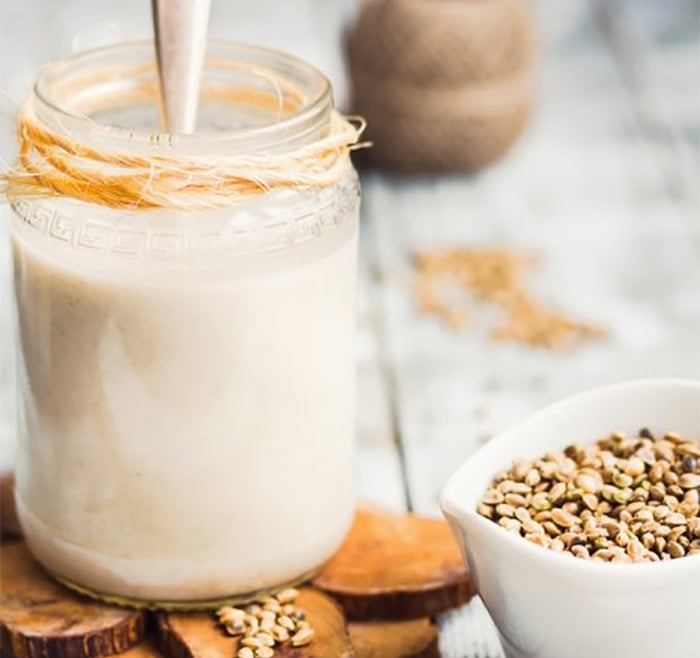
What is hemp milk made of?
Hemp milk is made of hemp seeds. While these seeds come from the cannabis plant, they are non-psychoactive and do not contain any THC. Instead, they are packed with nutritional benefits which we’ll get into shortly.
Taste, colour, and consistency
Hemp milk is most similar to almond milk in both texture and taste. While creamy, it is more like skim milk. It is slightly nutty. If you’ve had hemp seeds before, you know that they have a mild flavour.
Hemp milk calories & nutrition
Based on Living Harvest hemp milk, you’re looking at the following macros and nutrients.
Per 1 cup (240 mL/8 oz.)
Calories: 70 kcal
Fat: 8 grams
Polyunsaturated fat: 6 grams
Monounsaturated fat: 1 gram
Cholesterol: 0 grams
Sodium: 125 mg
Carbohydrates: 1 gram
Protein: 2 grams
Vitamin A: 10%
Calcium: 30%
Iron: 6%
Vitamin D: 25%
Vitamin E: 8%
Riboflavin: 25%
Vitamin B12: 25%
Phosphorous: 20%
Magnesium: 10%
Zinc: 4%
Hemp milk pros
High in polyunsaturated fats. PUFAs are healthy fats and hemp is naturally rich with them. Plus, they maintain a lot of their nutritional integrity in the process of being milked. Most of their benefits come from their anti-inflammatory properties, including beneficial effects on insulin resistance. Various studies promise “antihypertensive, anticancer, antioxidant, antidepression, antiaging, and antiarthritis effects” (13).
Hemp is naturally calcium-rich. Many people worry about ditching dairy because they don’t think they will meet their calcium needs. Most dairy-free alternatives are fortified with calcium, but hemp seeds are naturally rich in this mineral. Good for the health of your bones and teeth!
Omega-3 fatty acids. These fatty acids are essential to good health and may have anti-inflammatory and antioxidant properties (14).
It’s sustainable. According to Good Hemp, “the plant grows naturally without the use of herbicides or pesticides and with very little water. It breathes in 4x more CO2 than trees, and nothing is wasted when producing food and drink from hemp” (15).
Hemp milk cons
- Costly and hard to find. Hemp milk isn’t the leading dairy alternative and its novelty means the price can be relatively high. Making it at home can reduce the cost, but hemp seeds alone can be rather expensive.
- Low-ish in protein. Compared to soy milk, it’s a little low in protein. Still, it beats almond milk and others!
Does hemp milk suit your diet?
Hemp milk is Paleo, vegan, vegetarian, lactose-free, nut-free, Whole30-compliant, gluten-free and ketogenic.
Buying hemp milk
Like with other dairy-free milk, try to avoid additives, oils, and sugars. Hemp milk is often hard to find and I’ve noticed it placed on dry shelves more than in the refrigerated section.
Using hemp milk
Hemp milk can be used in place of dairy milk in most recipes. It can separate rather easily compared to other alternatives, so keep that in mind. It does have some nutty undertones which may clash with certain foods. Otherwise, it is very versatile.

How to make hemp milk
Ingredients:
- ½ cup hemp seeds
- 4 cups of water
- A pinch of salt
- Sweetener or pitted dates to taste
Instructions:
- Blend both ingredients in a food processor or high-speed blender.
- Strain through a clean towel or nut milk strainer if you’d like, but it blends quite smooth.
VERDICT
If I had to pick a dairy-free milk substitute that meets all of the highest standards of nutrition and sustainability, hemp milk would be it. There are very few cons to having it, except that you have to find it first!
Cashew Milk
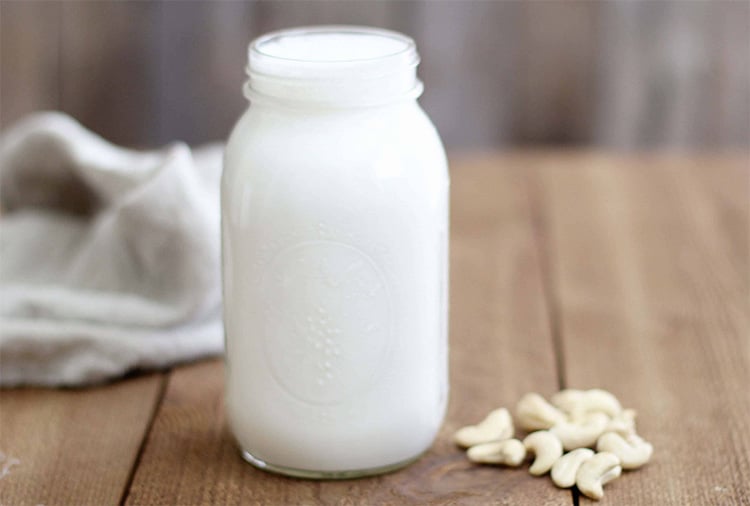
I have recently started seeing cashew milk on the market, which surprised me because cashew nuts have long been used to make dairy-free cheese alternatives and cheesecakes. It makes sense to make plant-based milk out of them too.
What is cashew milk made of?
Cashew milk is a blend of cashews and water.
Taste, colour, and consistency
Cashew milk is a lot like almond milk. It has a similarly nutty taste. It is less watery and has a bit more heft. It is white in colour.
Cashew milk CALORIES & nutrition
Based on the Silk unsweetened cashew milk brand, you’re looking at the following nutrients. However, these are based on a low percentage of cashews and you can get more protein, calories and fat (and micronutrients) if making your own cashew milk using more nuts. However, you may be missing out on fortified Vitamin D and calcium.
Per 1 cup (250 ml/8 oz.)
Calories: 25 kcal
Fat: 2 grams
Monounsaturated fat: 1 gram
Cholesterol: 0 grams
Sodium: 160 mg
Carbohydrates: 1 gram
Protein: < 1 gram
Vitamin D: 2.5 mcg
Calcium: 450 mg
Iron: 0.5 mg (2%)
Vitamin A: 15%
Vitamin E: 25%
Cashew milk pros
- Low in calories. Like almond milk, cashew milk is good food for weight loss as it’s much lower in calories than milk like soy or rice milk.
- Great texture. Cashew milk is creamier and richer than almond milk. If you prefer dairy milk, cashew is the preferable nut source as it blends to a much creamier consistency.
Cashew milk cons
- It’s better homemade. Homemade cashew milk is much higher in calories, but it’s also much higher in nutrients. The processing of cashews to make commercial “milk” products strips it of all its nutrients. Some are added back in during the fortification process, but it simply isn’t that impressive compared to some of the other choices,
- Not as sustainable. According to The Life Impact, 14,218 litres of water are used to produce a kilogram of cashews, or 1,704 gallons per pound (16). They do not, however, contribute to deforestation or have a very high carbon footprint otherwise.
Does cashew milk suit your diet?
Cashew milk is Paleo, vegan, vegetarian, lactose-free, Whole30-compliant, and ketogenic.
Buying cashew milk
Cashew milk can be bought in the refrigerated section or as a shelf-stable version. Often, it is sold in a blend; a common product is an almond and cashew mix. Cashew milk is fairly common but comparable to almond milk in case you are unable to find it at a certain store. As with almond milk, the higher % cashew content will result in creamier, richer-tasting drink.
Using cashew milk
Cashew milk can be used in place of regular milk as it is quite creamy. It is certainly interchangeable with almond milk and other nut milk. Many people make yoghurt out of thick cashew milk.
Cashew milk should last in the fridge for 5-7 days. Homemade cashew milk will last around 4 days. Shelf-stable cashew milk shouldn’t be kept longer than a year.
How to make cashew milk
Ingredients:
- 1 cup raw cashews
- 4 cups of water
- A pinch of salt
- Sweetener or pitted dates to taste
Instructions:
- Soak cashews overnight
- Drain the cashews and add to a high-speed blender or food processor with 2 cups of water. Blend cashews entirely. This can be tough! Make sure to give it enough time. Blend on low speed for a few minutes.
- Blend in the other 2 cups of water, salt, and any sweetener you might fancy.
- Strain through a nut milk bag. Refrigerate and enjoy for up to four days.
VERDICT
Cashew milk is fine, but it’s definitely not the all-star of store-bought nut milk. It’s totally worth making at home though! You will get great results and have a super creamy, delicious milk to use for any purpose. It does have versatility going for it.
Banana Milk
Say what? Yep, banana milk is a thing, although it is quite a new product on the market.
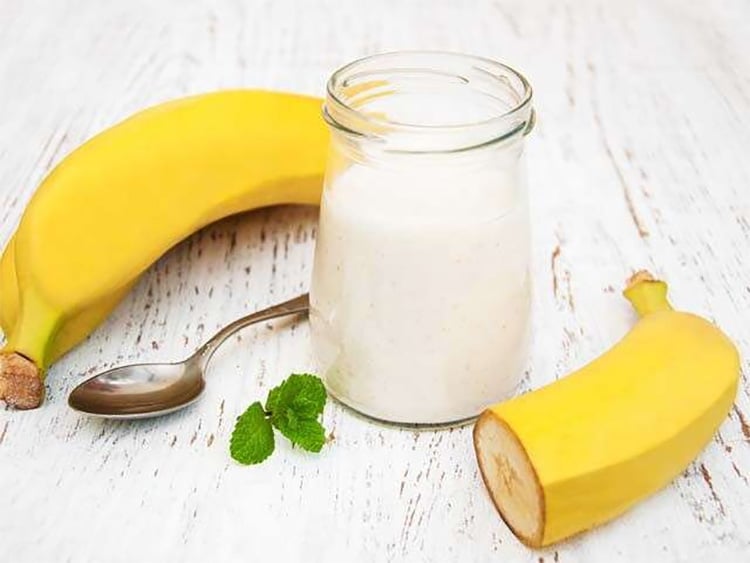
What is banana milk made of?
As you might imagine, banana milk is made of banana and water.
Taste, colour, and consistency
Banana milk tastes like bananas. There is no getting around this since it is like a simplified banana smoothie. It is creamy and starchy. The colour is pale yellow.
Banana milk CALORIES & nutrition
It’s tough to find a model for this as finding banana milk in-store can be a struggle – especially without added sugar. These nutrition facts are based on the homemade recipe provided below, or for one medium banana.
Calories: 105 kcal
Fat: 0.4 grams
Sodium: 1 mg
Potassium: 422 mg
Carbohydrates: 27 grams
Fibre: 3.1 grams
Sugar: 14 grams
Protein: 1.3 grams
Vitamin C: 17%
Vitamin B6: 20%
Magnesium: 8%
Pros of banana milk
- High in potassium. Potassium regulates blood pressure and reduces stroke risk (17). Banana is arguably the best single food source of the stuff, so eat up!
- It’s easy to make (and cheap!). Blending banana and water is so simple. You don’t necessarily need a high-speed blender considering it hardly needs to be emulsified compared to most nuts or seeds. Plus, bananas are much less expensive than any other ingredients found in milk alternatives.
Cons of banana milk
- It probably has to be homemade. Due to limited availability and loads of added sugar, you have to make it at home. Good news? It’s so easy, why not?
- It’s not very versatile. The distinct banana taste limits the uses of banana milk to sweet recipes.
- Low in protein and fat, high in sugar. Bananas are high in sugar and not much else. They do have some great nutritional qualities and fibre which is retained in the process of making the drink at home, but there’s not much to fill you up in this beverage.
Is banana milk suitable to your diet?
Banana milk is Paleo, vegan, vegetarian, lactose-free, nut-free, gluten-free and Whole30-compliant.
Buying banana milk
I’ve only recently started seeing banana milk appear in stores, and even then, availability seems limited. The original banana milk – Binggrae brand – has been around for 50+ years though they are based in Korea. Their product also contains dairy milk, but it is a model for what’s popping up now.
It does seem to come in a shelf-stable version though I’m sure you can find fresh banana milk with other juices or prepared fresh at juiceries. Watch out for the standard additives as the only real ingredients needed are bananas and water, and most products contain a lot more sugar and usually added protein. Blue Diamond – a nut milk brand – has a product made of almond milk mixed with banana which may be more common.
Using banana milk
Banana milk probably has the most limited uses of all dairy-free replacements on this list. Bananas are a SUPER sweet fruit so their milk is incredibly sweet as well. It makes an awesome dessert and I’m sure it would fit well into specific recipes. Oh, and it’s a great contender for a milkshake! However, it’s not the most versatile.
Homemade banana milk will last in the fridge for around two days. You can keep an open container of banana milk for around five days.
How to make a banana milk
Ingredients:
- 1 banana
- 1 cup of water
Instructions:
- Blend and enjoy!
VERDICT
Banana milk is simple and inexpensive to make at home. It is a fun treat and it tastes really delicious. If you’re a fan of banana, you will be a fan of this milk!
Regular Whole Milk
I thought that it makes sense to also include regular milk in this list because it’s useful to know its pros and cons. Here, I am talking about cows’ milk specifically.
Whole milk calories & nutrition
Per 1 cup of regular, full-fat cow’s milk
Calories: 150 kcal
Fat: 8 grams
Saturated fat: 4.6 grams
Polyunsaturated fat: 0.5 grams
Monounsaturated fat: 2 grams
Cholesterol: 24 mg
Sodium: 105 mg
Potassium: 322 mg
Carbohydrates: 12 grams
Sugar: 12 grams
Protein: 8 grams
Vitamin A: 7%
Calcium: 27%
Vitamin D: 31%
Vitamin B12: 18%
Pros of whole milk
- High in protein. Unlike most dairy-free substitutes with the exception of soy milk, dairy milk does contain a substantial amount of protein at 8 grams per cup. Combined with high-fat content, dairy milk is quite satisfying and filling.
- Potassium. Like banana, milk is quite high in potassium which, again, can reduce bad cholesterol and raise good cholesterol as well as reduce the risk of stroke.
- High in vitamins and minerals. Dairy milk is a good food source of hard-to-get nutrients such as calcium, vitamin D, and vitamin B12. Eliminating dairy can make it hard to reach the recommended daily value for these vitamins, but it is possible – especially with fortified milk replacements.
Cons of whole milk
- High in carbs and sugar. While the protein and fat balance out the carbohydrate factor, many people want low-carb milk or milk substitute. Whole milk doesn’t quite fit the bill, although many ketogenic eaters have heavy cream and cheese instead as they are much lower in sugar.
- Often, unethical and unsustainable production. Feeding cows uses 2.7 trillion gallons of water per year in California according to Take Part (18). Cattle are the most water-intensive ‘crop’ considering most land and water is used to grow pasture and alfalfa. Stack this on top of production in one of the driest states in the U.S., and one of the major dairy industries is falling super short on the sustainability list. In other places, the dairy industry is simply dwindling due to the rise in popularity of nut milk and recommendations from environmental organisations. However, this does depend on the farming practices of particular countries, regions and farmers, who strive for more ethical and sustainable production.
Buying whole milk
If you want to continue to consume regular milk, be very mindful of where it comes from and what practices the farmers use: how the cattle are raised, treated, fed and milked.
Lactose-Free Cow’s Milk
If you are lactose-intolerant and simply want to enjoy milk, there is the option of having lactose-free cow’s milk. This product has an added enzyme called lactase that breaks down lactose and converts it into glucose and galactose. This makes it easy to digest.
Unfortunately, lactose-free milk is produced the same way as regular dairy milk, thereby having the same problems. Non-dairy alternatives are typically healthier and much more sustainable for those with lactose intolerance.
Conclusion
Regular cow’s milk is nutritious, accessible and affordable, making it a popular choice in today’s society and for growing families. However, milk production causes ethical concerns about sustainability and animal welfare. Plus, many people have issues digesting the sugar and/or proteins in regular dairy milk or they are allergic.
It is, therefore, no surprise that so many people are looking for dairy-free milk alternatives. Luckily, we have plenty of delicious, creamy and sustainable non-dairy alternatives at our fingertips. This is a really positive change and means that you can choose an option that best suits your taste and dietary needs.
I hope you learned a lot today! Make sure to bookmark this article for later if you need a quick cheat sheet for milk substitutes. Let me know in the comments which milk is your favourite, or which one you’ve only just heard of and want to try.
Special thanks to my assistant writer Alex Barone for helping me collate a lof of the information for this article!
References
1. Almond Milk is Taking a Toll on the Environment
2. Here’s what happened when I started asking the almond industry about the ingredients in almond milk
3. Medium-Chain Triglycerides Lower Blood Lipids and Body Weight in Streptozotocin-Induced Type 2 Diabetes Rats
4. Effects of medium-chain triglycerides on weight loss and body composition: a meta-analysis of randomized controlled trials.
5. Medium Chain Triglycerides enhances exercise endurance through the increased mitochondrial biogenesis and metabolism
6. Impact of a Traditional Dietary Supplement with Coconut Milk and Soya Milk on the Lipid Profile in Normal Free Living Subjects
7. Biological Effect of Soy Isoflavones in the Prevention of Civilization Diseases
8. Soy isoflavone: The multipurpose phytochemical (Review)
9. Soy and Health Update: Evaluation of the Clinical and Epidemiologic Literature
10. A critical review of the toxicological effects of carrageenan and processed eucheuma seaweed on the gastrointestinal tract.
11. Cholesterol-lowering effects of oat β-glucan.
12. Rice
13. Health benefits of n-3 polyunsaturated fatty acids: eicosapentaenoic acid and docosahexaenoic acid.
14. Omega-3 Polyunsaturated Fatty Acids: Benefits and Endpoints in Sport.
15. Good Hemp vs. Other Milk
16. The Life Impact of: Cashews
17. The Importance of Potassium
18. Holy Cow! Crops That Use Even More Water Than Almonds


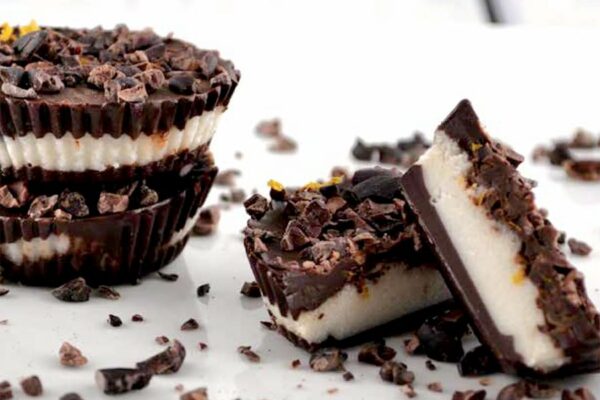

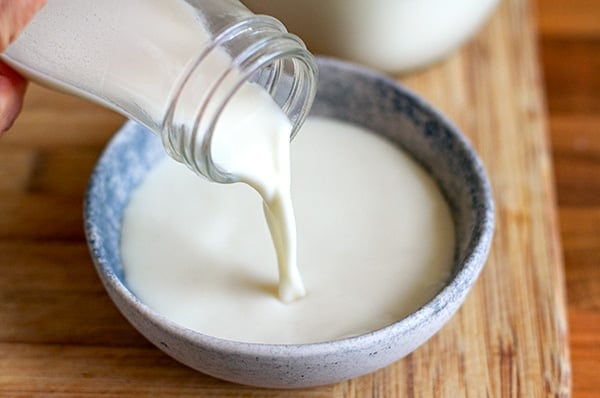
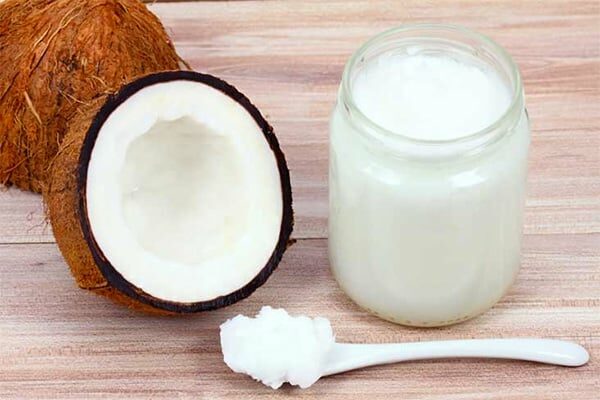
Comment or Rate This Recipe
Made the recipe? Please leave a rating as it helps other readers to discover this dish. You don’t need to leave a comment if rating a recipe, unless it’s 3 stars or below.
Comments
0 Comments